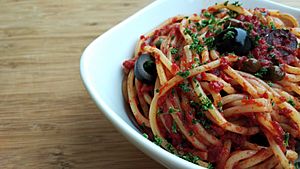Spaghetti alla puttanesca facts for kids

spaghetti alla puttanesca
|
|
| Alternative names | pasta alla puttanesca, pasta puttanesca |
|---|---|
| Course | Main |
| Place of origin | Italy |
| Region or state | Campania |
| Serving temperature | Hot |
| Main ingredients | Spaghetti, tomatoes, olives, capers, garlic |
| Variations | spaghetti alla puttanesca with anchovies or tuna |
Spaghetti alla puttanesca is a popular Italian pasta dish. It was created in Naples, Italy, around the middle of the 20th century. This tasty dish is usually made with spaghetti or vermicelli pasta. Its main ingredients include tomatoes, olive oil, olives, anchovies, chili peppers, capers, and garlic.
How the Dish Started
Even before it got its current name, similar pasta sauces existed in Italian cookbooks. One of the earliest recipes, from 1844, was called Vermicelli all'oglio con olive capperi ed alici salse. This means "vermicelli with oil, olives, capers, and anchovy sauce."
In 1931, a famous Italian guide listed a similar dish as a specialty of Campania. It was called "Maccheroni alla marinara" then. In Naples, people often called this type of sauce aulive e chiappariell, which means "olives and capers."
The name Spaghetti alla puttanesca first appeared in books in the 1960s. A novel from 1961, Ferito a Morte, mentioned "spaghetti alla puttanesca as they make it in Syracuse." This sauce became very popular during the 1960s.
One story about how the dish got its name comes from Sandro Petti. He was the co-owner of a restaurant in Ischia, Italy, in the 1950s. One evening, Petti had very few ingredients left. Some hungry customers asked him to "make for us whatever you got!" Petti only had four tomatoes, two olives, and some capers. He used these simple ingredients to make a sauce for spaghetti. He later added this dish to his menu as spaghetti alla puttanesca.
Making the Dish
The sauce for this dish is called sugo alla puttanesca. Recipes can change a bit depending on where you are. For example, the version from Naples does not use anchovies. The version popular in Lazio usually includes them.
The sauce is often a little salty because of the capers, olives, and anchovies. It also has a strong, delicious smell from the garlic. While it's traditionally served with spaghetti, you can also enjoy it with other pasta shapes. These include penne, bucatini, linguine, and vermicelli.
To make the sauce, garlic and anchovies (if used) are cooked in olive oil. Then, chopped chili peppers, olives, capers, diced tomatoes, and oregano are added. Salt and black pepper are added for taste. This mixture is cooked until it thickens. Finally, it's poured over al dente spaghetti and topped with fresh parsley.
See also
 In Spanish: Spaghetti alla puttanesca para niños
In Spanish: Spaghetti alla puttanesca para niños

